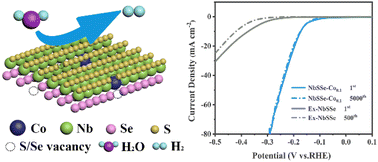Post cobalt doping and defect engineering of NbSSe for efficient hydrogen evolution reaction†
Abstract
Group VB transition metal dichalcogenides (TMDs) show a metallic nature and are potential catalysts applied in the hydrogen evolution reaction (HER). Ternary structures and element doping are the dominant methods to improve HER performance. Herein, chemical vapor transport (CVT)-grown NbSSe was post-doped with cobalt atoms by the hydrothermal method for the first time to produce metallic 2D electrocatalysts used for the HER. The post-doped cobalt in NbSSe not only enhanced the HER performance, but also improved the hydrogen evolution stability. Due to the conductive phase of NbSSe and abundant active sites created by ternary structures and Co-doping, the 10% Co-doped NbSSe exhibits a low overpotential of 173 mV at a current density of 10 mA cm−2, a Tafel slope of 64 mV dec−1, and good durability, which are comparable to or better than those of most previously reported ternary TMD systems. Compared with pristine NbSSe, the Co-doped NbSSe shows a 220 mV decrease in overpotential at 10 mA cm−2. Both theoretical calculations and experimental data indicate that more defects created by the Co-doping and ternary structure resulted in a lower H* adsorption energy, giving a better HER performance. This work presents a new, efficient catalyst for the HER and the cation post doping could be extended to other ternary TMD electrocatalysts to improve the catalytic performance.



 Please wait while we load your content...
Please wait while we load your content...